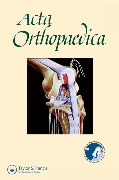
No significant difference in 10-yr migration between high & low viscosity cement in THA .
Palacos compared to Palamed bone cement in total hip replacement: a randomized controlled trial
Acta Orthop. 2016 Oct;87(5):473-839 patients scheduled for cemented total hip arthroplasty were randomized to receive either low viscosity bone cement or high viscosity bone cement. The purpose of this study was to compare femoral component migration via radiostereometric analysis (RSA) over a 10-year follow-up. The results of this study demonstrated no significant differences between groups in femoral component translation or rotation over the follow-up.
Unlock the Full ACE Report
You have access to 4 more FREE articles this month.
Click below to unlock and view this ACE Reports
Unlock Now
Critical appraisals of the latest, high-impact randomized controlled trials and systematic reviews in orthopaedics
Access to OrthoEvidence podcast content, including collaborations with the Journal of Bone and Joint Surgery, interviews with internationally recognized surgeons, and roundtable discussions on orthopaedic news and topics
Subscription to The Pulse, a twice-weekly evidence-based newsletter designed to help you make better clinical decisions
Exclusive access to original content articles, including in-house systematic reviews, and articles on health research methods and hot orthopaedic topics
































































